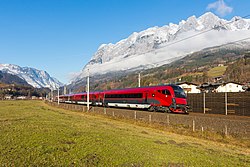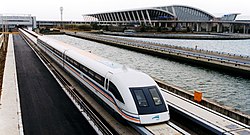History
Innovations from the late 19th century, such as the world's first electric train, when Siemens & Halske unveiled a train in which power was supplied through the rails, and the world's first electric tram, with the implementation of 2.5-kilometer-long electric tramway located in Berlin, built at the company's own expense, cemented the use of electric power in transportation systems.
In the following years, inventions such as the first electric trolleybus, mine locomotives, and the first underground railway in continental Europe (in Budapest), set the path from trams and subways to today's high-speed trains. [5]
Siemens, alongside ThyssenKrupp and Transrapid International, was part of the German consortium that built the Shanghai Maglev, inaugurated in 2002 by the German chancellor, Gerhard Schröder, and the Chinese premier, Zhu Rongji. [6] It was the world's first commercial high-speed magnetic levitation train, which holds the title of the fastest commercial service, travelling up to 430 km/h. [7]
In November 2012, Siemens acquired Invensys Rail for £1.7 billion. [8]
In July 2017, Siemens confirmed it had taken over Hannover-based software company HaCon, to be managed as a separate legal entity. The financial details were not disclosed. [9]
In September 2017, Siemens announced a proposal to merge its transportation division with Alstom, with the objective of creating "a new European champion in the rail industry". [10] The combined rail business, to be named Siemens Alstom and headquartered in Paris, would have had $18 billion U.S. in revenue and employed 62,300 people in more than 60 countries. [11] It was seen as a measure to counter the rise of China's CRRC with support from both the French and German governments. [12] However, in February 2019, the European Commission refused permission for the merger to proceed. [13]
During Innotrans in September 2018, Siemens Mobility unveiled the world's first driverless tram in Berlin, [14] the result of a joint research and development project with ViP Verkehrsbetriebe Potsdam, on a six-kilometre section of the tram network in Potsdam, Germany.
This page is based on this
Wikipedia article Text is available under the
CC BY-SA 4.0 license; additional terms may apply.
Images, videos and audio are available under their respective licenses.






